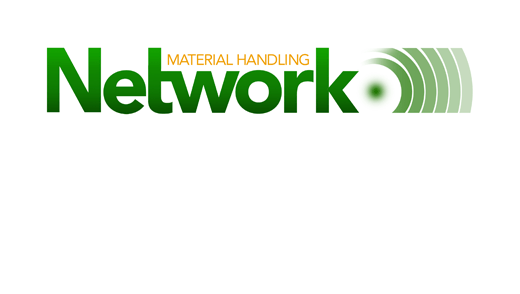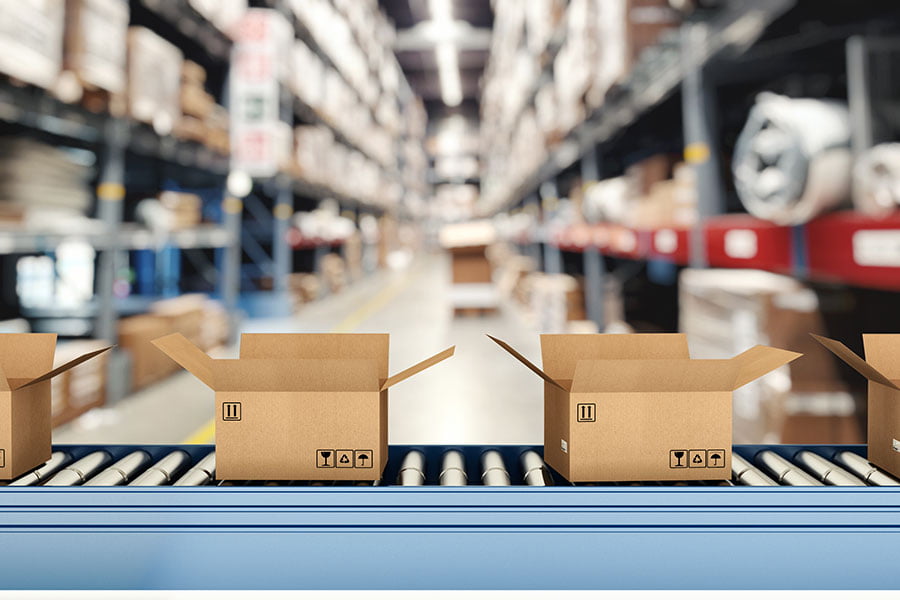Published March 16, 2017
Executive Introduction
The methods and costs of final mile delivery are at the forefront of eCommerce business models. Quick delivery at a low cost is the mantra of online retailing. Customer expectations continue to guide the supply chain, whether it is day or night, weekend or holiday, customers expect quick delivery. It is exciting to think about the possibilities of having instant gratification for a pressing need or simply for personal fulfillment. Whether, it is a critical time saving convenience or the satisfaction of personal fulfillment, practicality is on a collision course with expectations.
Customer expectations are achieved when an organization places the customer at the core of their business strategy. When the organization contemplates the impact of every decision of the customer and when the organization is dedicated to responding to the consumer’s needs and desires.
Final delivery done well is important to achieving customer satisfaction. The choices a business makes on final delivery will change their profit margin. The costs for final delivery actually begin upstream, with the structure of the distribution network, the way in which consolidation / de-consolidation is conducted, and the efficiency of the modes and carriers in routing and scheduling from the import hub to the destination. If the correct choices are made, final delivery will improve a business’s supply chain.
This paper discusses drones. Drones are going to become an option for final mile delivery in the future. Amazon first started the hype of using drones for small package delivery. Will drones become the next best option for final delivery and meeting customer expectations? We believe there is still a lot to be understood about the rules, regulations, and costs of using drones for final mile delivery.
Current Limitations
Drone delivery sounds like a unique and potentially 21st Century solution to final mile delivery, but a business must consider the current limitations:
- Few homes and work places have sufficient space for drones to land or drop packages.
- Drones are not all-weather vehicles capable of navigating through high wind, rain, and / or snow.
- Drones have limited capacity for lift.
- The limited range of drones precludes delivery to most suburban and rural areas.
- The cost of drone delivery, may limit it to a few who are willing to pay more than a premium price for the convenience.
Current Regulatory Environment
For drones to be a viable option for small package delivery, major hurdles such as government regulations, drone capabilities, and the cost of operations need to be addressed.
To protect the general public, government regulations have tight restrictions on where drones may fly and what physical capabilities the drone may have. The FAA fact sheet Small Unmanned Aircraft Regulations commonly known as Part 107, outlines the requirements for operating drones. The regulation uses the terminology Small Unmanned Aircraft (UAS) as its drone moniker.
The operator of a drone must have a remote pilot airman certificate with a UAS rating. Obtaining this certificate is not a simple task. A drone operator must pass a technical exam covering a broad range of aviation topics, insuring an in-depth understanding of FAA rules and regulations relevant to UAS flight. The exam is not easy and requires concerted effort and investment on the part of the applicant. Drone operators are skilled and are paid accordingly.
FAA regulations limit drone physical capabilities to less than 55 pounds including payload. This could be a serious limiting factor since the lifting capability of a drone has an inverse relationship between the actual weight of the drone and the payload. Two things impose a huge restraint on drone capability, battery life and battery weight. For a drone a bigger payload means a bigger battery inferring a process toward diminishing returns for payload capability. Typically for a drone to lift more it would weigh more however, there are drones coming to market with payload capabilities of up to 22 pounds, which is half the weight of the drones airframe. One should expect the FAA limit of 55 pounds to be challenged. The Prodrone PD6B-AW-ARM has a 22 pound lift capability and includes five-axis metal claws. This drone is eerily similar to the Imperial Probe Droid in Star Wars Episode V. Heavy lift drones are not cheap.
Even though the FAA regulations are quite restrictive there are exceptions. The FAA will grant a waiver for some of the rules if the operator can show safe and plausible reasons for granting the waiver. Primarily, the FAA is seeking to protect the general public from unnecessary perils. There is a plethora of internet videos showing drone mishaps with people, animals, and buildings. Waivers for Part 107 include:
- Operations from a Moving Vehicle or Aircraft ( 107.25)
- Day Operations ( 107.29)
- Beyond Visual Line of Sight ( 107.31)
- Visual Observer ( 107.33)
- Operating Multiple UAS ( 107.35)
- Yielding the Right of Way ( 107.37 (a))
- Operations Over People ( 107.39)
- Operations in Certain Airspace ( 107.41)
The waiver application process can get technically convoluted and usually requires the assistance of a third party advocate. The waiver process is not cheap.
Operations in airspace could be an easily overlooked issue, as drones need a place of deployment. If the volume expands then more and more drones are needed. Air traffic around the drone deployment area could get overcrowded. Does this imply that the FAA may have some futuristic drone air traffic controllers?
Probably the biggest hurdle for drone deployment is the requirement for pilot visibility. This is the most restrictive part of the regulation because it severely limits the range of drone delivery. If an operator has to follow the drone to make a package delivery then the operator might as well deliver the package. It is essential that drones work without a pilot. Proving that a pilotless drone is safe is challenge number one. It will be done, just as there are driverless cars. Project Perdix, undertaken by the Pentagon, has already demonstrated autonomous capabilities in a swarm of 104 drones dropped from three F16’s traveling at nearly the speed of sound. With the military demonstrating autonomous capabilities in their applications, it will not be long before civilian applications are developed and approved.
As a corollary to the military swarm, Amazon has received a patent for a swarm of drones to be released from a blimp at high altitude. The Perdix drones are made from 3-D printed parts and are cheap. Maybe Amazon is considering one-way-throw-away drones for delivery from the blimp. The blimp would be a hovering warehouse at 45,000 feet. Too high for a drone to make a return trip, so why not 3-D print a drone and drop it out for delivery? The customer may keep the drone as a souvenir or dispose of it properly in the recycle bin.
Considering all of the restrictions, in time drones will be acceptable in airspace over roads, power lines, rights-of-way, etc. When automobiles were first introduced they were considered a threat to horses. Now we see the proliferation of driverless cars. Technology will find a way.
Estimated Costs of Drone Operations
There is an indirect relationship between the costs of delivery and the time it takes for package delivery.
The costs are illustrated by the below graph:
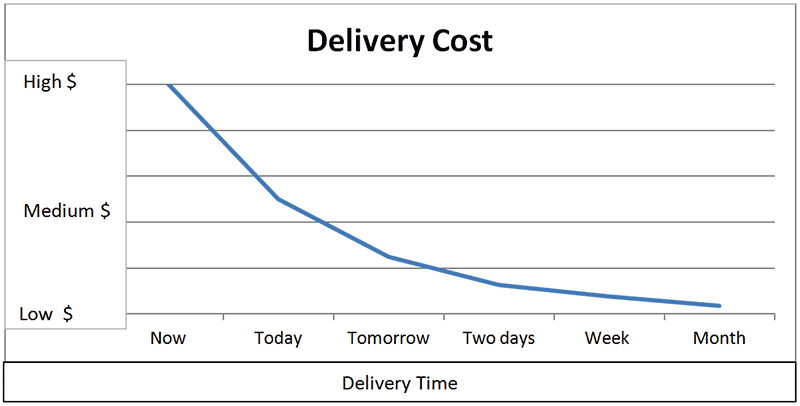
As time is compressed, the costs grow.
What should a business understand for the cost of drone delivery? Costs are broken down to three primary categories: labor, depreciation, and overhead. Developmental costs are included in the depreciation function.
For the labor portion of the cost there has to be a pilot and the pilot’s manager. Also, add staff such as maintenance and ground support personnel.
Drone Pilot $75,000 per year plus benefits = $88,500
Management $110,000 per year plus benefits = $129,800
Maintenance $62,000 per year plus benefits = $73,160
Ground Support $45,000 per year plus benefits = $53,100
Obviously, it is not a one-to-one ratio for each of these people per drone. Therefore, let the human resource costs be spread this way:
Pilot 100% $88,500
Management 5% $6,490
Maintenance 5% $3,658
Ground Support 5% $2,655
Total $101,303
What items should be included for depreciation, the drone itself, but also control functions and software development.
Drone Cost $120,000
Drone Docking Facility $65,000
Drone Pilot Cockpit $110,000
Maintenance and Ground Support Space $78,000
Total Depreciable Items $373,000
Per year based on seven year straight line depreciation: $53,142
Expense items are the last category:
Utilities $3,500
Fuel $26,000
Supplies $5,500
Miscellaneous $4,200
Total Supplies $39,200
Total annual cost $193,645
Using a benchmark of $6.00 per delivery, it would take 32,274 deliveries for a drone to pay for itself. This would mean drone deliveries must average 620 occurrences per week, almost 90 deliveries per day or nine per hour for a 10 hour day.
At nine deliveries per hour each delivery must be less than six minutes and 40 seconds long. When flying at an average speed of 35 MPH a drone would be able to deliver within a 1.9 mile radius, if it flew out and back for each delivery. For drone delivery to be economically feasible, the delivery cost would have to come in somewhere near three times the benchmark of $6.00.
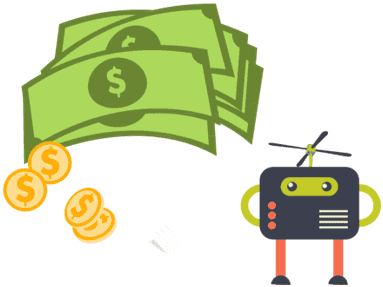
Amazon has taken the lead in drone delivery, but Google and Walmart have now entered the field for developing drone delivery systems. Maybe the cost barrier can be broken, but it would have to be done with volume and lower operating costs. A drone pilot would have to be capable of controlling multiple drones. The pilot would have to be willing to accept a lower salary than stated above. The cost of the drone itself would have to be a few thousand dollars.
Possible Applications: Four Scenarios
Drones could have a viable application for package delivery with these scenarios:
- Homes desiring drone delivery would have a designated drone landing pad. The front door is hard to access. A designated pad would work for individual home delivery. This would first be seen in up-scale housing, which typically has large open areas surrounding the house and would add that touch of unique luxury.
- Up-scale apartments / condos would have balconies designed to serve as drone landing pads. Some visionary building designers have already developed concepts incorporating drone delivery.
- The United States Postal Service (USPS) currently delivers seven days a week for Amazon. Each office of the USPS would have a drone landing pad for not only Amazon, but others using drone delivery. USPS is uniquely positioned to become the most efficient and cost effective last mile delivery service due to the number of locations and low cost
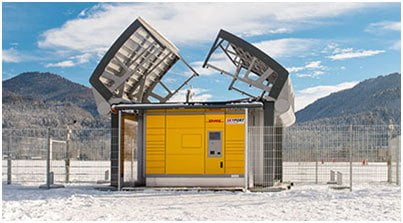 delivery vehicles. Drone delivery to a post office would capture the low per package cost associated with carrying a number of packages in one flight.
delivery vehicles. Drone delivery to a post office would capture the low per package cost associated with carrying a number of packages in one flight. - There can also be Click & Collect hubs. This would be similar to a community mailbox configuration as used in apartment complexes. A drone could deliver multiple packages to an automated pick-up point that would produce the customer package when the correct access code is entered at the pick-up station somewhat like the DHL Packstation.
Ground Based Drones
There is one more dimension of drone delivery that needs to be mentioned, ground based drones. The usual thought about drones is through the air, but there may be an application for a drone that would travel down the sidewalk to make deliveries or possibly the roadways. This technology is also moving forward rapidly, but is not getting as much attention. The ground based drone is more suited for “heavy lift” use, such as grocery delivery. The grocery business operates on a tight margin so a low cost delivery system could in a sense, bring home the bacon within reasonable costs. Grocers are already offering curbside pick-up therefore the drone delivery would add the extra dimension needed for persons, such as the elderly, to obtain groceries without having to venture out.
The ground based drone would work well in places such as retirement communities. These communities are usually in areas with mostly flat streets and low traffic. Most of these communities are gated areas with good security. Residents would order online or via telephone with delivery provided in less than an hour. The drone could be programmed to recognize the address and use facial recognition for allowing the customer to open the drone for retrieving the delivery.
A major advantage for ground based drone development is the lack of government regulations. Without the hindrance of regulations like that of the aerial drone, as discussed earlier, prototype development and testing can move ahead at the pace of the developer rather than at the pace of government regulators.
The tables are somewhat turned on the ground based drone. The aerial drone is regulated because it may pose a hazard to humans, whereas humans may pose a threat to the ground based drone. It certainly would be a target for some miscreants. Self protection would have to be part of the programming but certainly not as intense as the electrical shock from the lovable Star Wars droid R2D2.
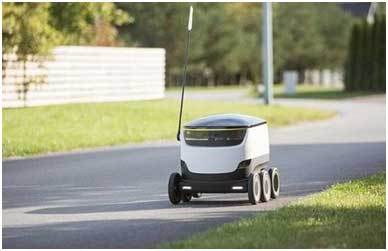
An Alternative Solution: The MonarchFx Alliance
As noted, DHL has integrated the drone into their delivery chain. Where does drone technology actually fit into the bigger picture of retailing, the consumer, and delivery services? No doubt, Amazon has revolutionized eCommerce with forward based fulfillment centers. Instead of one Fulfillment Center (FC) servicing the entire country, FC’s are strategically placed near population centers so that delivery times may be reduced to hours, rather than days. Amazon has accomplished this strategic move by frantically building FC’s during the last few years. They have done this entirely within their corporate management structure. This go-it-alone mentality may work for Amazon, but for most retailers, resources are not available to build a network of forward based FC’s. One should consider entering The MonarchFx Alliance. This alliance is poised to give retailers the edge necessary to compete in eCommerce using a world class alliance of logistics and supply chain specialists. Retailers in the eCommerce environment must be able to balance the uni-channel fulfillment experience with the omni-channel marketing challenge. Uni-channel fulfillment is concerned with delivering products to customers with a completely unified experience while omni-channel marketing is concerned with marketing through cell phones, online experiences, and retail stores.
The benefit of The MonarchFx Alliance is that the economy of scale can be achieved through the use of shared resources. Instead of having to absorb overhead by being alone in the market place, alliance members have overhead spread across a greater volume. Volume is accomplished by intermingling inventory of the alliance members. Overhead allocation to unit sales then becomes a smaller allocation due to the cumulative volume effect produced by an alliance.
Amazon has self-made its way into the economy of scale by incorporating multitudes of novice marketers into the Amazon fulfillment network. Fulfillment by Amazon (FBA) allows Amazon to build huge inventories thus spreading the overhead cost over this vast sea of marketers who may or may not be able to sell their wares. Amazon ran into a logistical nightmare in late 2015 due to FBA having inventory that did not move. This prompted Amazon to install a punishing fee schedule for FBA members having inventory remaining in FC’s through the holiday season of 2016.
On the other hand, MonarchFx has a unique business model synergizing world class brands with unique products offered nowhere else. The difference between MonarchFx and Amazon is the collaboration of best in class fulfillment and delivery experts with professional retailers and marketers.
To achieve an uni-channel fulfillment experience there have to be systems robust enough to absorb the flood tide of online orders for events such as the time compressed period known as Black Friday through Cyber Monday. The demand through omni-channel marketing can be overwhelming during this period for online retailers. Self-developed legacy systems can easily grind to a halt due to these kinds of volumes. To overcome sharp spikes of online traffic, a retailer needs access to modular, scalable, and flexible systems developed by world class system developers and systems integrators. The MonarchFx infrastructure allows this capability by leveraging world class technology to optimize inventory allocation.
In late 2015, Amazon had maximum occupancy in their existing FC’s resulting in severe limitations to meeting promised delivery services. They were not able to see it coming and flexed to meet the challenge. MonarchFx is an alliance of best in class providers of supply chain technology, third party logistics, final mile delivery, material handling integration, and real estate services. This alliance offers a cadre of professionals who have flexible existing capacity able to efficiently absorb seasonal peaks. Amazon’s future capacity is dependent on how fast they are able to build a FC. On the other hand, world class 3PL’s offer capacity ahead of the curve.
To say the market place has been disrupted by Amazon is an understatement. To say there are digital disruptions in the market place is reality, but there is profit in disruption. The correct response to these disruptions is business model reinvention:
- Reinvention through partnerships with other market leaders
- Reinvention through logistics agility in a growing eCommerce environment
- Reinvention through shipping from a network of local fulfillment centers
- Reinvention through efficient and robust final mile delivery capabilities
- Reinvention through marketing focus with fulfillment and delivery as a value added services
Drones are just one aspect to consider when planning for final mile delivery. One should also consider The MonarchFx Alliance as a means for cost effective final mile delivery, MonarchFX does not replace a seller’s logistics ecosystem; rather, complements the seller’s logistics ecosystem. The vision of MonarchFx is to be the preferred direct-to-consumer logistics provider, operating with the lowest cost, while delivering the highest levels of customer service, and providing superior value for MonarchFx sellers. The mission of MonarchFx is to create, build, and manage a substantial logistics ecosystem that establishes MonarchFx Alliance members to become the preferred direct-to-consumer logistics solution in the United States.
Summary and Conclusion
The technology challenges will be solved. The government regulations will be tailored to protect the general public and allow the technology to flourish. It is not a matter of if, but rather when. The when is now closer than ever. On December 14, 2016, Amazon made its first drone delivery to an estate a bit like Downton Abbey in the Cambridge area of the United Kingdom. The first delivery contents were a Fire TV and a bag of popcorn. From click to delivery was thirteen minutes, not counting the paces the lord of the house had to walk to the drone landing pad. The actual landing site was a number of steps away from the front door.
On the other hand, Amazon is not truly the first to make drone deliveries. DHL has successfully integrated drone delivery logistically into its delivery chain. Between January and March 2016, DHL made cycles of loading and offloading drone pick-up and delivery services in a remote region of Bavaria. Customers inserted their packages into what DHL calls their Parcelcopter Skyport which then initiated the automated services for a drone to retrieve the outbound parcel and deliver any inbound parcels. DHL is now poised for field trials in urban areas.
Final mile delivery is one of the most expensive parts of package delivery. The application of drone technology could have a major impact on bringing down this cost. As discussed earlier the initial costs will be high, but as the technology develops and regulations allow drones will be an integral part of everyday life.
Within this bigger picture of reinventing business, the drone will have a place but it is not necessarily crucial to success in the market place. What is crucial is having a robust supply chain strategy for moving aggressively through the 21st century meeting customer expectations.
